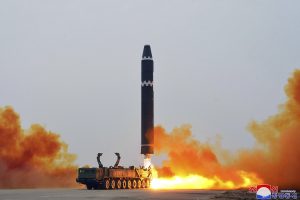North Korea launched its Hwasong-15 intercontinental ballistic missile (ICBM) on Saturday, according to the North’s state-controlled media, Korean Central News Agency (KCNA). The missile flew 989 km with a maximum altitude of 5,768 km.
The ICBM launch came a day after a spokesperson of the North’s Foreign Ministry vowed to step up “counteractions” to the South Korea-U.S. combined military drills.
Saturday’s launch was not planned but carried out according to “the written order” with “a personal signature” of the North’s supreme leader Kim Jong Un, according to KCNA.
When test-firing a spate of short-range ballistic missiles (SRBMs) last year, North Korea skipped reporting details of the performances of the tested missiles. To show off its advanced long-range missile capabilities to confront the United States and South Korea, however, it released specifics on the performance of Hwasong-15, along with the background of the testing.
“The surprise ICBM launching drill, conducted in the present situation under which the military threats of the U.S. and South Korea are getting serious to the extent that cannot be overlooked, is an actual proof of the DPRK strategic nuclear force’s consistent efforts to turn its capacity of fatal nuclear counterattack on the hostile forces into the irresistible one as well as a guarantee for and a clear proof of the sure reliability of our powerful physical nuclear deterrent,” KCNA said. (DPRK is an acronym of North Korea’s official name: Democratic People’s Republic of Korea.)
A day after the Hwasong-15 launch, Kim Yo Jong, the powerful sister of Kim Jong Un and the main voice on inter-Korean relations, published a follow-up statement.
“The U.S. would be well-advised to stop saying that it is not hostile toward the DPRK and the door to dialogue is open, hoodwinking the world, and to give up its foolish trick for earning the time through dialogue,” Kim said. “And it should stop all the actions posing threats to the security of our state and refuse to tarnish the DPRK’s dignity, always thinking twice for its own future security.”
Stating the South Korea-U.S. military drills are “destroying the stability of the region,” Kim also threatened the United States by saying that the North’s ICBMs “will not be aimed at Seoul.”
In another statement published on Monday, Kim said “the frequency of using the Pacific as our firing range depends upon the U.S. forces’ action character.”
Hours after Kim’s statement was published by KCNA on Sunday, South Korea’s Joint Chiefs of Staff (JCS) announced that the South Korean and the U.S. militaries conducted combined air drills on the east coast of the Korean Peninsula as corresponding action to the North’s Hwasong-15 ICBM launch. A dozen military aircraft – including the U.S. B-1B Lancer strategic bomber and F-16 and the South’s F-35 A and F-15 K – were mobilized during the drills, according to the JCS.
As Seoul and Washington have pledged to expand their combined military drills, the two sides carried out an immediate joint air drill “to demonstrate the capabilities of the U.S. extended deterrence in the region.”
On Monday, North Korea fired two SRBMs into its eastern waters sometime between 7 a.m. to 7:11 a.m., according to the South’s JCS. North Korea said the two tested SRBMs were its 600mm multiple rocket launchers and the missiles flew 395 km and 337 km, respectively, to target “the western front set virtual targets.”
“The 600 mm multiple rocket launcher, involved in the firing, is the latest type of multiple launch precision attack weapon system of the KPA,” KCNA said. “It is a tactical nuclear attack means boasting of the great might powerful enough to assign only one multiple rocket launcher with four shells so as to destroy an enemy operational airfield.”
Considering the range of the tested missiles and the KCNA report, they seem to target air force bases of the South Korean and the U.S. militaries – such as the bases where the South and the U.S. fighter jets had taken off for the combined air drills on Sunday.
“Through today’s firing drill with the involvement of super-large multiple rocket launchers, the tactical nuclear attack means, the KPA fully demonstrated its full readiness to deter and will to counter the U.S. and South Korean combined air force bragging about their air superiority,” KCNA said.
Calling the North’s ballistic missile launches a grave act of provocation, Seoul’s JCS strongly condemned it and urged Pyongyang to immediately halt the missile launches.
South Korean Foreign Ministry announced on Monday its unilateral sanctions on four individuals and five organizations that contributed to the North’s nuclear and missile development, and efforts to evade sanctions. The Ministry said it is the fourth unilateral sanctions measure on North Korea since under the Yoon Suk-yeol administration. On February 10, it announced its unilateral sanctions on North Korea for its illicit cyber activities.
South Korea and the United States will hold joint military drills in the coming weeks, involving a one-day table-top exercise and the Freedom Shield exercise, an 11-day regular springtime combined military drill. The tit-for-tat measures between the two Koreas will likely be continued – which would escalate the tensions on the Korean Peninsula further.
































